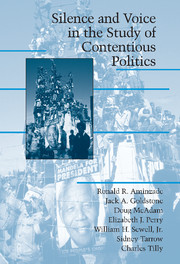Book contents
- Frontmatter
- Contents
- Preface
- 1 SILENCE AND VOICE IN THE STUDY OF CONTENTIOUS POLITICS: INTRODUCTION
- 2 EMOTIONS AND CONTENTIOUS POLITICS
- 3 SPACE IN CONTENTIOUS POLITICS
- 4 IT'S ABOUT TIME: TEMPORALITY IN THE STUDY OF SOCIAL MOVEMENTS AND REVOLUTIONS
- 5 LEADERSHIP DYNAMICS AND DYNAMICS OF CONTENTION
- 6 THE SACRED, RELIGIOUS, AND SECULAR IN CONTENTIOUS POLITICS: BLURRING BOUNDARIES
- 7 THREAT (AND OPPORTUNITY): POPULAR ACTION AND STATE RESPONSE IN THE DYNAMICS OF CONTENTIOUS ACTION
- 8 CONTENTION IN DEMOGRAPHIC AND LIFE-COURSE CONTEXT
- 9 HARMONIZING THE VOICES: THEMATIC CONTINUITY ACROSS THE CHAPTERS
- References
- Index
8 - CONTENTION IN DEMOGRAPHIC AND LIFE-COURSE CONTEXT
Published online by Cambridge University Press: 05 June 2012
- Frontmatter
- Contents
- Preface
- 1 SILENCE AND VOICE IN THE STUDY OF CONTENTIOUS POLITICS: INTRODUCTION
- 2 EMOTIONS AND CONTENTIOUS POLITICS
- 3 SPACE IN CONTENTIOUS POLITICS
- 4 IT'S ABOUT TIME: TEMPORALITY IN THE STUDY OF SOCIAL MOVEMENTS AND REVOLUTIONS
- 5 LEADERSHIP DYNAMICS AND DYNAMICS OF CONTENTION
- 6 THE SACRED, RELIGIOUS, AND SECULAR IN CONTENTIOUS POLITICS: BLURRING BOUNDARIES
- 7 THREAT (AND OPPORTUNITY): POPULAR ACTION AND STATE RESPONSE IN THE DYNAMICS OF CONTENTIOUS ACTION
- 8 CONTENTION IN DEMOGRAPHIC AND LIFE-COURSE CONTEXT
- 9 HARMONIZING THE VOICES: THEMATIC CONTINUITY ACROSS THE CHAPTERS
- References
- Index
Summary
To call a concern with demographic and life-course processes a silence in the study of contentious politics is something of an exaggeration. It would probably be more accurate to term it a muted voice in contemporary scholarship and, sticking with the auditory analogy, a faint echo from older research traditions. If we consider only contemporary scholarship, there has been a low-level, but persistent, interest in the long-term biographical impact of social movement participation (DeMartini 1983; Demerath, Marwell, and Aiken 1971; Fendrich 1977; 1993; Fendrich and Tarleau 1973; Marwell, Aiken, and Demerath 1987; McAdam 1988; 1989; McAdam, Van Dyke, Shockey, and Munch 1998; Sherkat and Blocker 1997; Whalen and Flacks 1989). On the “independent variable” side, there has also been a stress on the role of “biographical availability” as a factor mediating recruitment to individual activism (McAdam 1986; Snow and Rochford 1983; Wiltfang and McAdam 1991).
Besides these contemporary emphases, several older research traditions also stress the role of demographic or life-course processes as either causes or consequences of individual activism. Perhaps the most enduring of these traditions is rooted in Mannheim's influential concept of the “political generation” (1952). Political generations emerge when particular birth cohorts are exposed to highly distinctive life experiences during adolescence or young adulthood. Mannheim clearly counted generalized social and political unrest – what we might now call a “protest cycle” – among these “distinctive life experiences.” Such experiences are thought to mark these cohorts for life, leaving them with characteristic world views, and political orientations and commitments.
- Type
- Chapter
- Information
- Silence and Voice in the Study of Contentious Politics , pp. 195 - 221Publisher: Cambridge University PressPrint publication year: 2001
- 27
- Cited by

